Effect of Coil Configuration on Conversion Efficiency of EMAT on 7050 Aluminum Alloy
Abstract
:1. Introduction
2. Model Development
2.1. Mathematic Model
2.2. Geometrical Configuration
2.3. Model Validation
3. Results and Discussion
3.1. Effect of Coil Cross-Sectional Area
3.2. Effect of Coil Wire Cross-Sectional Shape
3.3. Effect of Distance between Coil Wires
4. Conclusions
Acknowledgments
Author Contributions
Conflicts of Interest
References
- Dobbs, E.R.; Llewellyn, J.D. Generation of ultrasonic waves without using a transducer. Non-Destr. Test. 1971, 4, 49–56. [Google Scholar] [CrossRef]
- Moran, T.J.; Panos, R.M. Electromagnetic generation of electronically steered ultrasonic bulk waves. J. Appl. Phys. 1976, 47, 2225–2227. [Google Scholar] [CrossRef]
- Thompson, R.B. Generation of horizontally polarized shear waves in ferromagnetic materials using magnetostrictively coupled meander-coil electromagnetic transducers. Appl. Phys. Lett. 1979, 34, 175–177. [Google Scholar] [CrossRef]
- Thompson, R.B. The relationship between radiating body forces and equivalent surface stresses: Analysis and application to EMAT design. J. Nondestr. Eval. 1980, 1, 79–85. [Google Scholar] [CrossRef]
- Lee, J.K.; Kim, Y.Y. Tuned double-coil EMATs for omnidirectional symmetric mode lamb wave generation. NDT E Int. 2016, 83, 38–47. [Google Scholar] [CrossRef]
- Wang, S.; Kang, L.; Li, Z.; Zhai, G.; Zhang, L. 3-D modeling and analysis of meander-line-coil surface wave EMATs. Mechatronics 2012, 22, 653–660. [Google Scholar] [CrossRef]
- Edwards, R.S.; Dixon, S.; Jian, X. Characterisation of defects in the railhead using ultrasonic surface waves. NDT E Int. 2006, 39, 468–475. [Google Scholar] [CrossRef]
- Zhao, X.; Varma, V.K.; Mei, G.; Ayhan, B.; Kwan, C. In-line nondestructive inspection of mechanical dents on pipelines with guided shear horizontal wave electromagnetic acoustic transducers. J. Press. Vessel Technol. 2005, 127, 304–309. [Google Scholar] [CrossRef]
- Clough, A.R.; Edwards, R.S. Characterisation of hidden defects using the near-field ultrasonic enhancement of Lamb waves. Ultrasonics 2015, 59, 64–71. [Google Scholar] [CrossRef] [PubMed]
- Nagy, P.B.; Simonetti, F.; Instanes, G. Corrosion and erosion monitoring in plates and pipes using constant group velocity Lamb wave inspection. Ultrasonics 2014, 54, 1832–1841. [Google Scholar] [CrossRef] [PubMed]
- Cheng, L.; Kogia, M.; Mohimi, A.; Kappatos, V.; Selcuk, C.; Gan, T.H. Crack characterisation using invariable feature extraction in stainless steel specimen used for absorber tubes of CSP applications via EMAT. Renew. Energy 2017, 101, 771–781. [Google Scholar] [CrossRef]
- Nakamura, N.; Ogi, H.; Hirao, M. EMAT pipe inspection technique using higher mode torsional guided wave T (0, 2). NDT E Int. 2017, 87, 78–84. [Google Scholar]
- Petcher, P.A.; Potter, M.D.G.; Dixon, S. A new electromagnetic acoustic transducer (EMAT) design for operation on rail. NDT E Int. 2014, 65, 1–7. [Google Scholar] [CrossRef]
- Petcher, P.A.; Dixon, S. Weld defect detection using PPM EMAT generated shear horizontal ultrasound. NDT E Int. 2015, 74, 58–65. [Google Scholar] [CrossRef]
- Shi, W.; Wu, Y.; Gong, H.; Zhang, T.; Tan, L.; Han, L.; Yang, J.; Li, W. Optimal design of spiral coil electromagnetic acoustic transducers considering lift-off sensitivity operating on non-ferromagnetic media. Nondestr. Test. Eval. 2016, 9, 1–19. [Google Scholar] [CrossRef]
- Clough, M.; Fleming, M.; Dixon, S. Circumferential guided wave EMAT system for pipeline screening using shear horizontal ultrasound. NDT E Int. 2017, 86, 20–27. [Google Scholar] [CrossRef]
- Thring, C.B.; Fan, Y.; Edwards, R.S. Focused Rayleigh wave EMAT for characterisation of surface-breaking defects. NDT E Int. 2016, 81, 20–27. [Google Scholar] [CrossRef]
- Thring, C.B.; Fan, Y.; Edwards, R.S. Multi-coil focused EMAT for characterisation of surface-breaking defects of arbitrary orientation. NDT E Int. 2017, 88, 1–7. [Google Scholar] [CrossRef]
- Quan, G.; Mao, Y.; Li, G.; Lv, W.Q.; Wang, Y.; Zhou, J. A characterization for the dynamic recrystallization kinetics of as-extruded 7075 aluminum alloy based on true stress–strain curves. Comput. Mater. Sci. 2012, 55, 65–72. [Google Scholar] [CrossRef]
- Pei, C.; Zhao, S.; Xiao, P.; Chen, Z. A modified meander-line-coil EMAT design for signal amplitude enhancement. Sens. Actuators Phys. 2016, 247, 539–546. [Google Scholar] [CrossRef]
- Isla, J.; Seher, M.; Challis, R.; Cegla, F. Optimal Impedance on Transmission of Lorentz Force EMATs; AIP Publishing: Melville, NY, USA, 2016. [Google Scholar]
- Ashigwuike, E.; Balachandran, W.; Thomas, S.; Mackay, R. Numerical study of EMAT coil structure based on finite element method. Pet. Technol. Dev. J. 2013, 3, 8–24. [Google Scholar]
- Huang, S.; Zhao, W.; Zhang, Y.; Wang, S. Study on the lift-off effect of EMAT. Sens. Actuators Phys. 2009, 153, 218–221. [Google Scholar] [CrossRef]
- Griffiths, D.J. Introduction to Electrodynamics; Prentice Hall: Upper Saddle River, NJ, USA, 1962. [Google Scholar]
- Reitz, J.R.; Milford, F.J.; Christy, R.W. Foundations of Electromagnetic Theory; Addison-Wesley Publishing Company: Boston, MA, USA, 2008. [Google Scholar]
- Cheng, D.K. Field and Wave Electromagnetics; Addison Wesley: Boston, MA, USA, 1989. [Google Scholar]
- Jin, J.M. The Finite Element Method in Electromagnetics; John Wiley & Sons: Hoboken, NJ, USA, 2015. [Google Scholar]
- Ribichini, R.; Cegla, F.; Nagy, P.B.; Cawley, P. Experimental and numerical evaluation of electromagnetic acoustic transducer performance on steel materials. NDT E Int. 2012, 45, 32–38. [Google Scholar] [CrossRef]
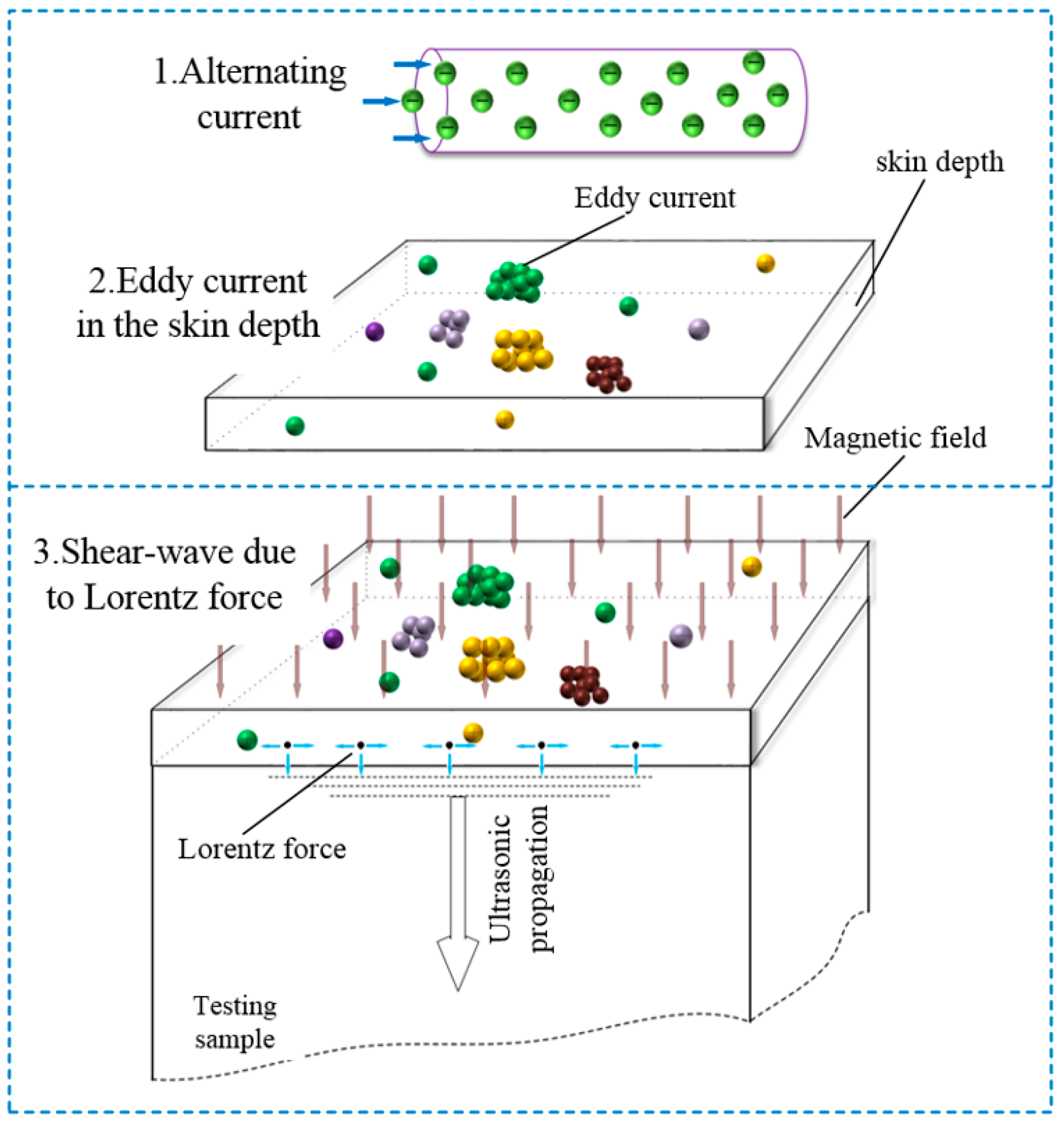
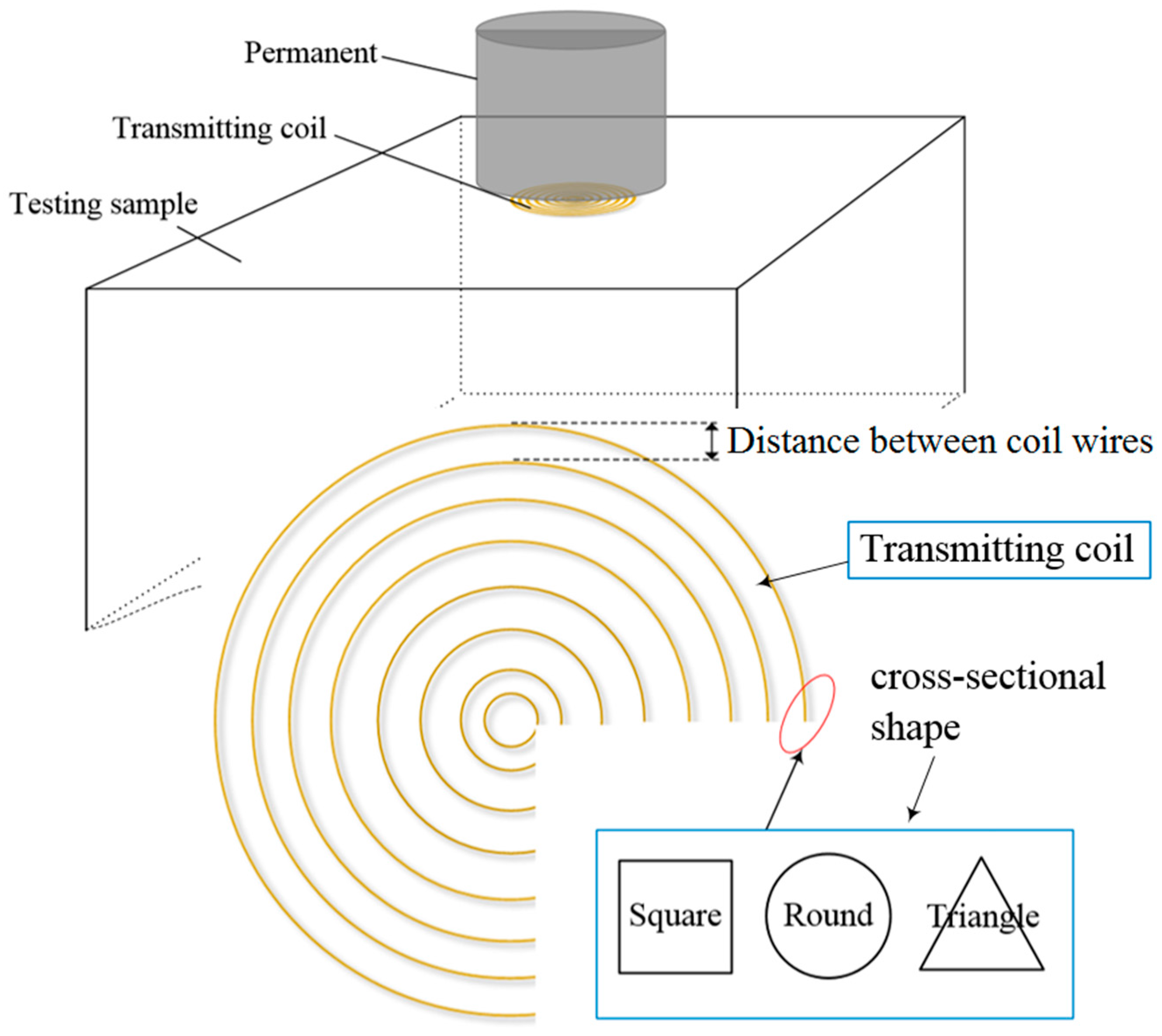
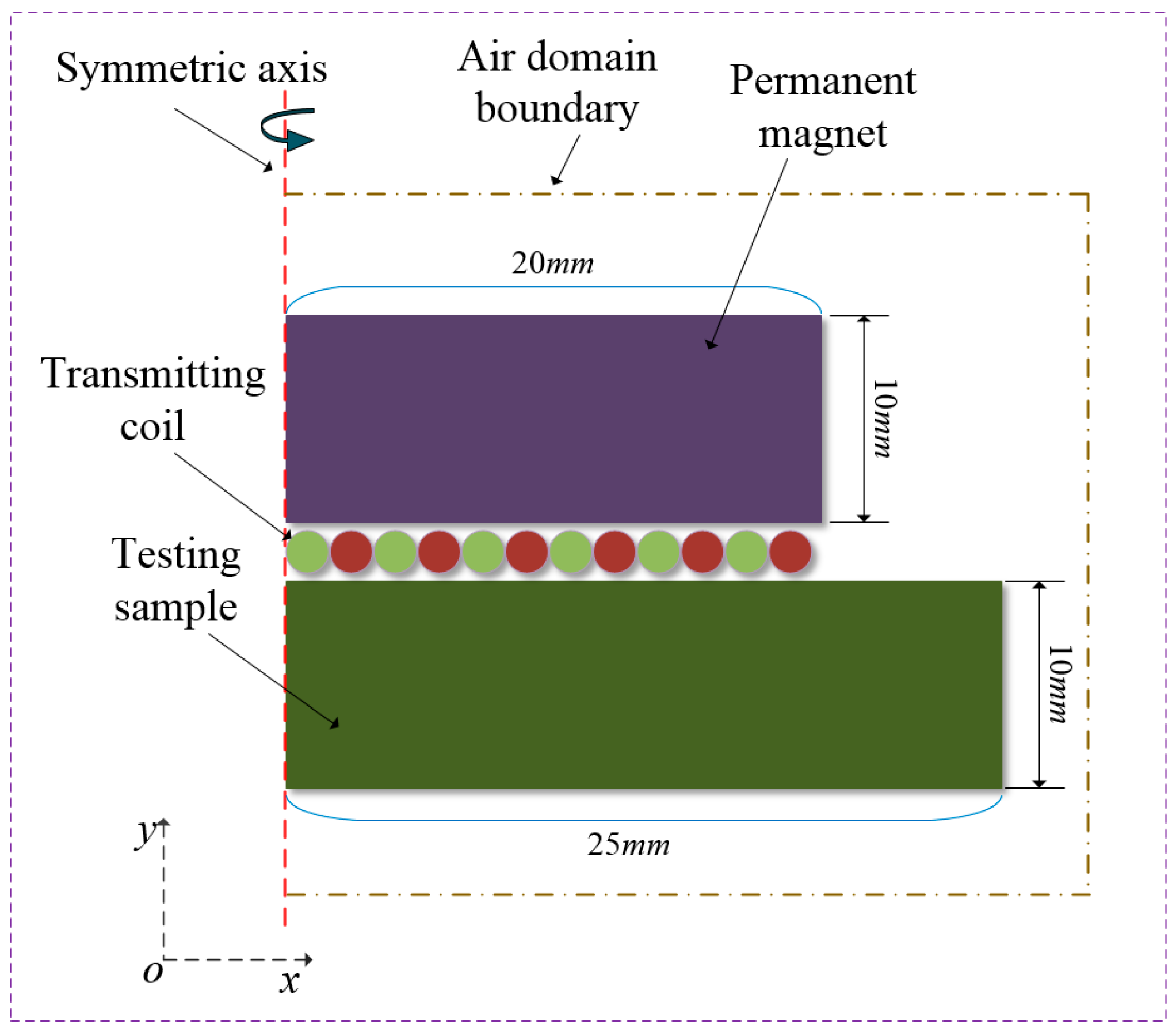
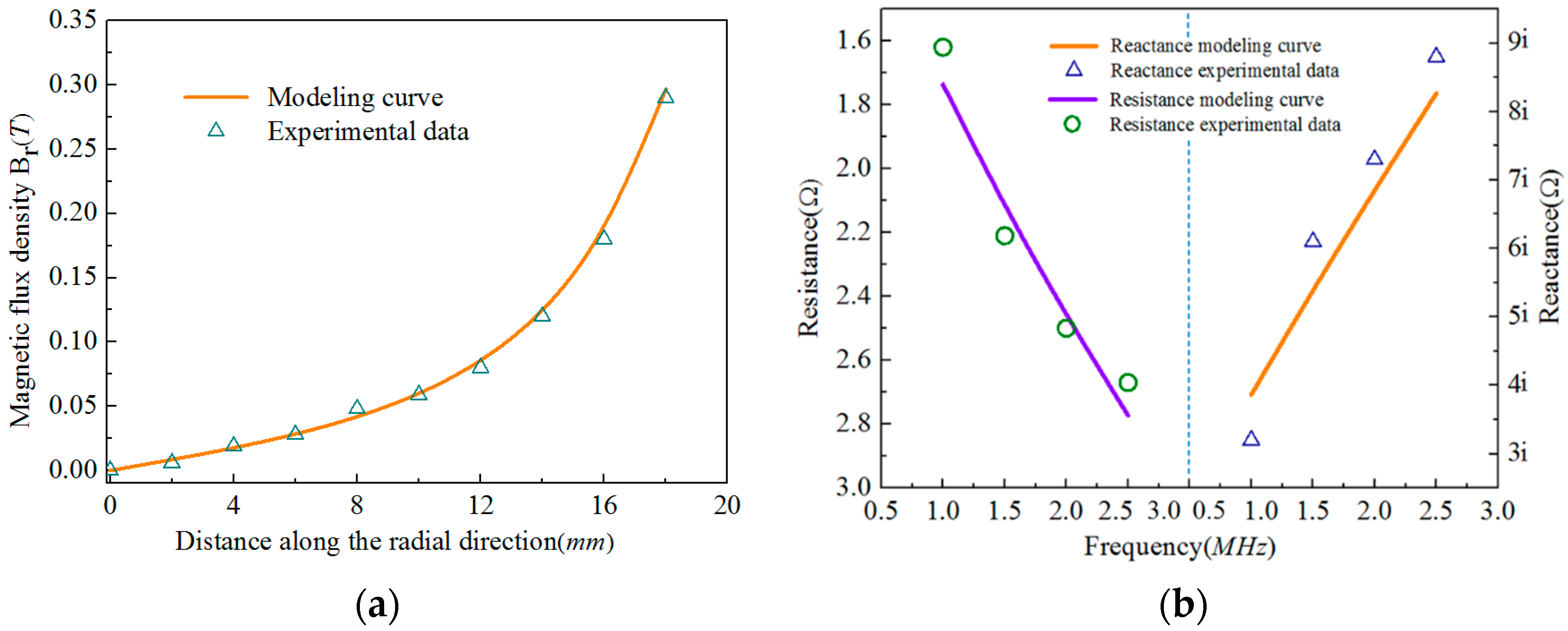
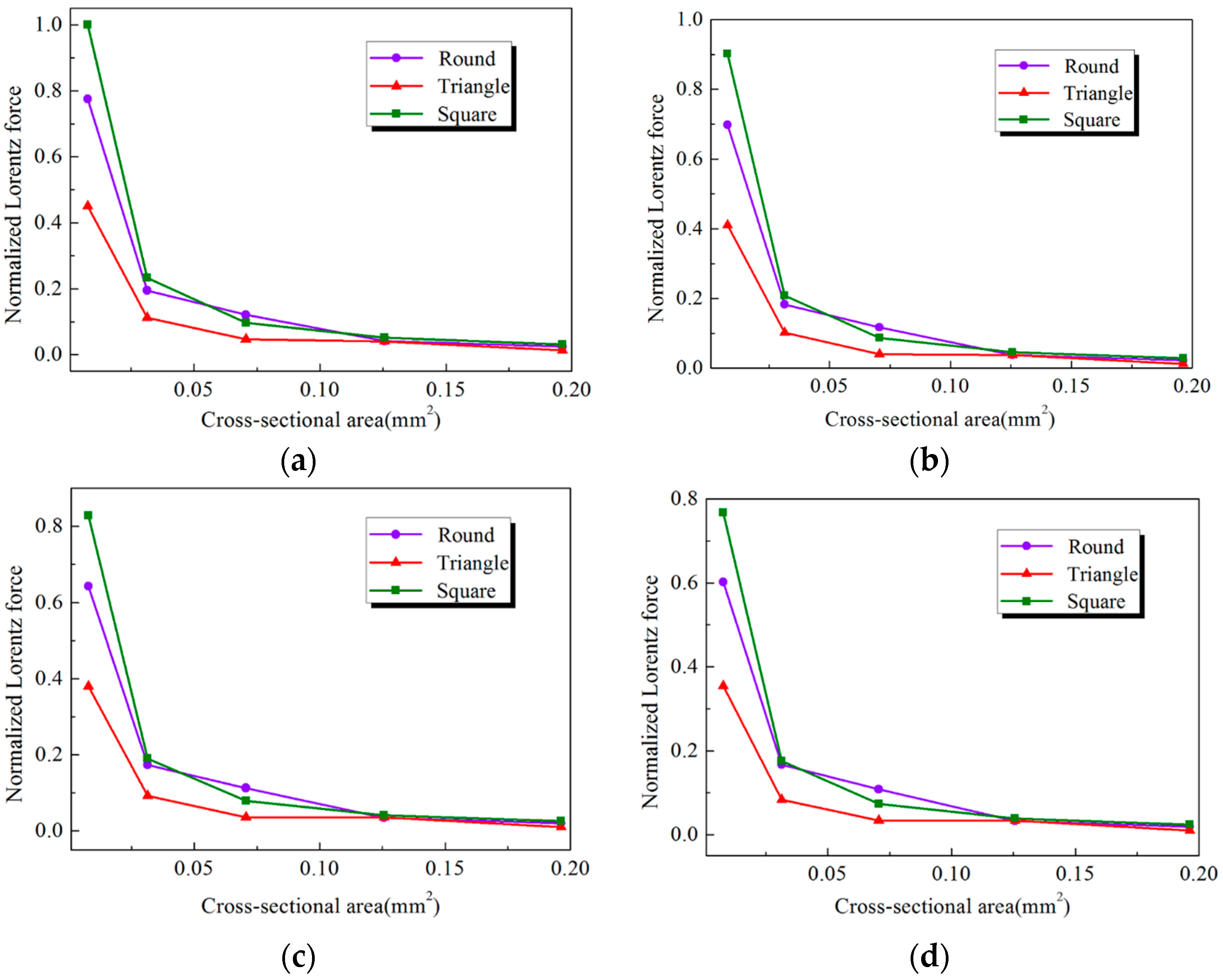

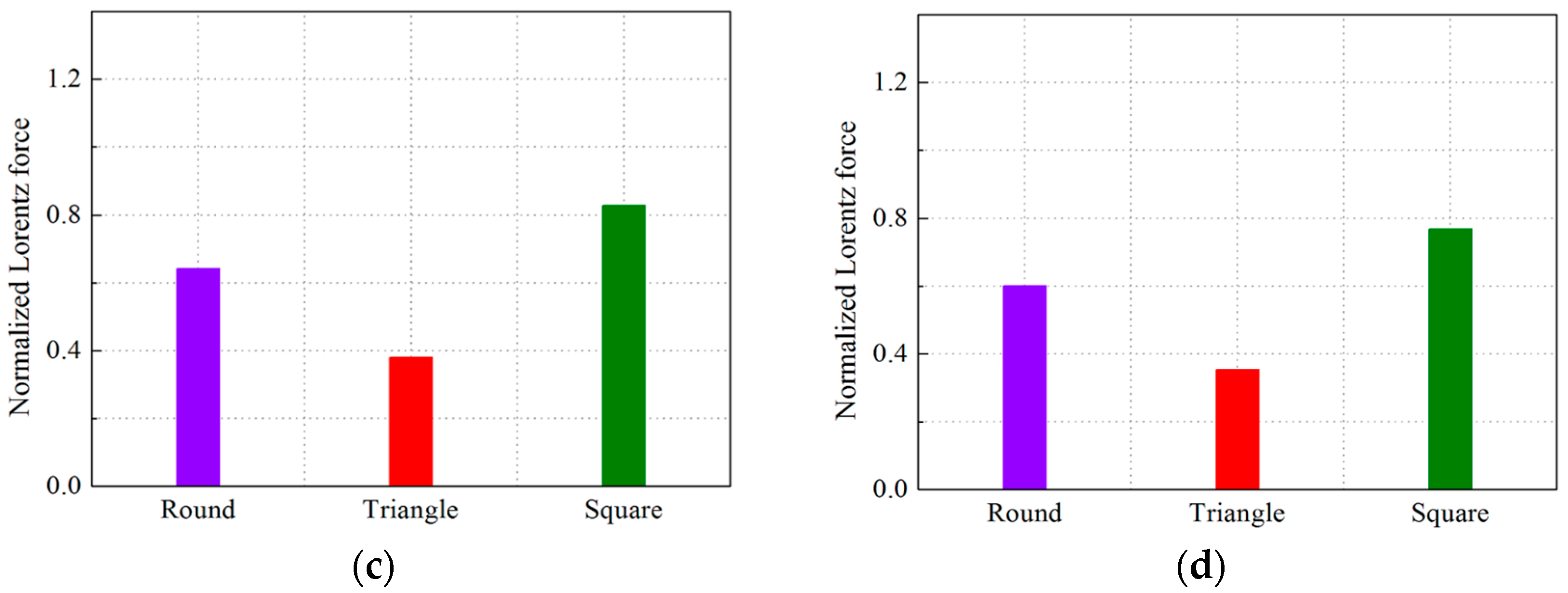
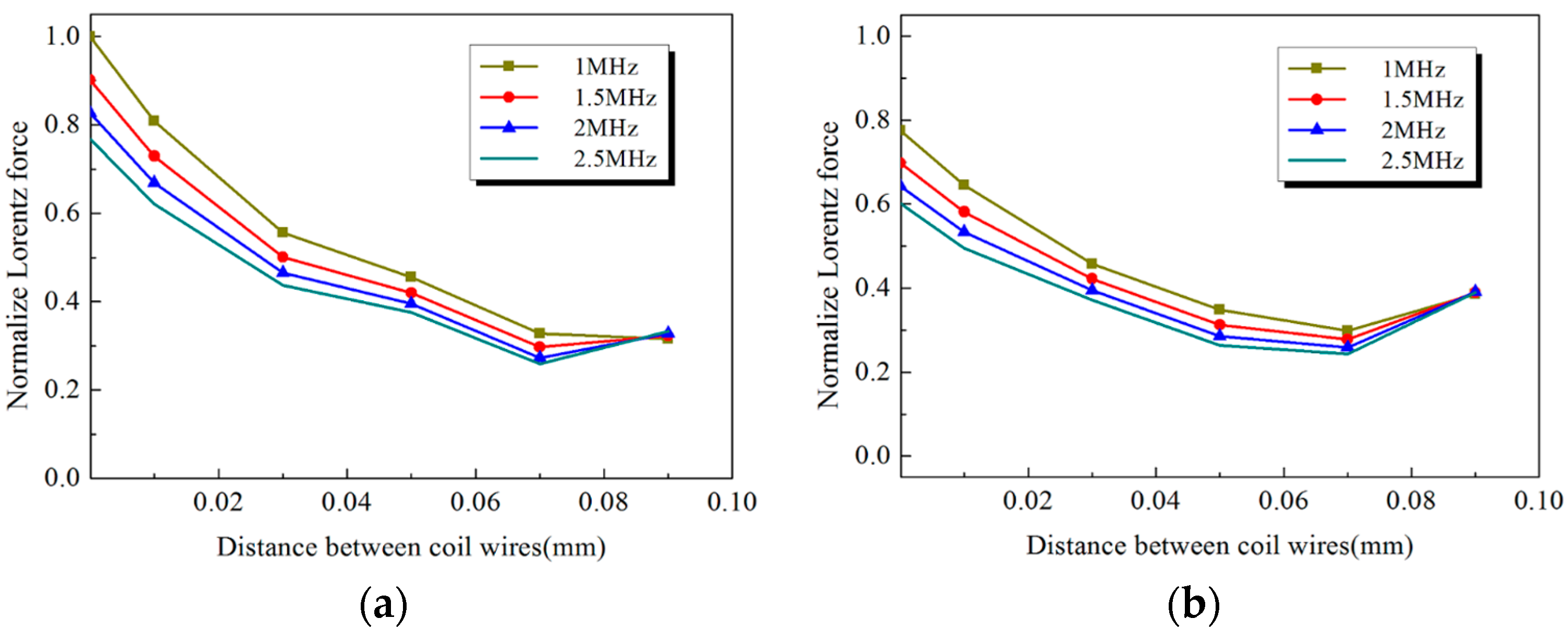
| Description, Symbol | Value, Unit |
|---|---|
| Remanent flux density, Br | 1.2 T |
| Relative permeability | 1 |
| Relative permittivity | 1 |
| Coil radius | 9.5 mm |
| Lift-off | 0.1 mm |
| Transmitting coil current | 30 A |
| Electrical conductivity, Al | |
| Electrical conductivity, magnet | |
| Electrical conductivity, coil | |
| Permanent magnet size | |
| Test sample size |
| Description | Value |
|---|---|
| Frequency (MHz) | 1, 1.5, 2, 2.5 |
| Coil cross-sectional area (mm2) | 0.00785, 0.0314, 0.07065, 0.1256, 0.19625 |
| Coil wire cross-sectional shape | Round, Triangle, Square |
| Distance between coil wires (mm) | 0.01, 0.03, 0.05, 0.07, 0.09 |
© 2017 by the authors. Licensee MDPI, Basel, Switzerland. This article is an open access article distributed under the terms and conditions of the Creative Commons Attribution (CC BY) license (http://creativecommons.org/licenses/by/4.0/).
Share and Cite
Wu, Y.; Han, L.; Gong, H.; Yang, J.; Li, W. Effect of Coil Configuration on Conversion Efficiency of EMAT on 7050 Aluminum Alloy. Energies 2017, 10, 1496. https://doi.org/10.3390/en10101496
Wu Y, Han L, Gong H, Yang J, Li W. Effect of Coil Configuration on Conversion Efficiency of EMAT on 7050 Aluminum Alloy. Energies. 2017; 10(10):1496. https://doi.org/10.3390/en10101496
Chicago/Turabian StyleWu, Yunxin, Lei Han, Hai Gong, Jiangang Yang, and Wei Li. 2017. "Effect of Coil Configuration on Conversion Efficiency of EMAT on 7050 Aluminum Alloy" Energies 10, no. 10: 1496. https://doi.org/10.3390/en10101496




